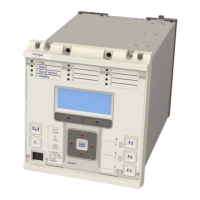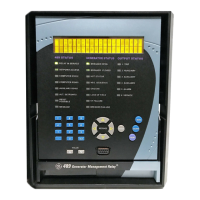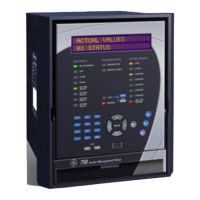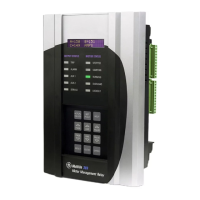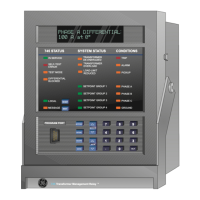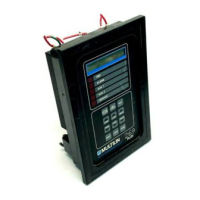Appendix B -Settings and Signals
MENU TEXT COL ROW DEFAULT SETTING AVAILABLE OPTIONS
DESCRIPTION
Value, once the channel recovers.
IM2 DefaultValue 20 36 0
0 or 1
[Unsigned Integer(16 bit)]
Setting that defines the IM2 fallback status.
IM3 Cmd Type 20 38 Permissive
Permissive
Setting that defines the operative mode of the received InterMiCOM_3 signal.
When ‘Direct’ tripping is chosen, for security reasons 2 consecutive valid messages have to be received before a change in the signal status
will be acknowledged. That will impose an additional 1-2 ms delay comparing to ‘Permissive’ mode.
Set ‘Direct’ in Direct Transfer Tripping (Intertripping) applications.
Set ‘Permissive’ to accommodate any Permissive or Blocking scheme.
IM3 FallBackMode 20 39 Default
Latched
Setting that defines the status of IM3 signal in case of heavy noise and message synchronization being lost.
If set to Latching the last valid IM3 status will be maintained until the new valid message is received.
If set to Default, the IM3 status, pre-defined by the user in IM3 Default Value cell will be set. A new valid message will replace IM3 Default
Value, once the channel recovers.
IM3 DefaultValue 20 3A 0
0 or 1
[Unsigned Integer(16 bit)]
Setting that defines the IM3 fallback status.
IM4 Cmd Type 20 3C Permissive
Permissive
Setting that defines the operative mode of the received InterMiCOM_4 signal.
When ‘Direct’ tripping is chosen, for security reasons 2 consecutive valid messages have to be received before a change in the signal status
will be acknowledged. That will impose an additional 1-2 ms delay comparing to ‘Permissive’ mode.
Set ‘Direct’ in Direct Transfer Tripping (Intertripping) applications.
Set ‘Permissive’ to accommodate any Permissive or Blocking scheme.
IM4 FallBackMode 20 3D Default
Latched
Setting that defines the status of IM4 signal in case of heavy noise and message synchronization being lost.
If set to Latching the last valid IM4 status will be maintained until the new valid message is received.
If set to Default, the IM4 status, pre-defined by the user in IM4 Default Value cell will be set. A new valid message will replace IM4 Default
Value, once the channel recovers.
IM4 DefaultValue 20 3E 0
0 or 1
[Unsigned Integer(16 bit)]
Setting that defines the IM4 fallback status.
IM5 Cmd Type 20 40 Permissive
Permissive
Setting that defines the operative mode of the received InterMiCOM_5 signal.
When ‘Direct’ tripping is chosen, for security reasons 2 consecutive valid messages have to be received before a change in the signal status
will be acknowledged. That will impose an additional 1-2 ms delay comparing to ‘Permissive’ mode.
Set ‘Direct’ in Direct Transfer Tripping (Intertripping) applications.
Set ‘Permissive’ to accommodate any Permissive or Blocking scheme.
IM5 FallBackMode 20 41 Default
Latched
Setting that defines the status of IM5 signal in case of heavy noise and message synchronization being lost.
If set to Latching the last valid IM5 status will be maintained until the new valid message is received.
If set to Default, the IM5 status, pre-defined by the user in IM5 Default Value cell will be set. A new valid message will replace IM5 Default
Value, once the channel recovers.
IM5 DefaultValue 20 42 0
0 or 1
[Unsigned Integer(16 bit)]
Setting that defines the IM5 fallback status.
IM6 Cmd Type 20 44 Permissive
Permissive
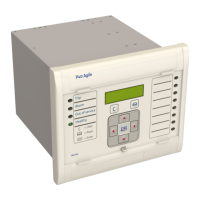
